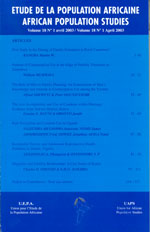
|
African Population Studies
Union for African Population Studies
ISSN: 0850-5780
Vol. 23, No. 2, 2008, pp. 141-154
|
 Bioline Code: ep08008
Bioline Code: ep08008
Full paper language: English
Document type: Research Article
Document available free of charge
|
|
|
African Population Studies, Vol. 23, No. 2, 2008, pp. 141-154
| fr |
Otieno, Alfred Agwanda
Résumé
L'arrêt du déclin de la fécondité ces dernières années au Kenya alarme la communauté des démographes. Bien que ce phénomène ne soit pas nouveau, il est aussi possible que les tendances de fécondité telle que mesurée par l'indice conjoncturel de fécondité (ICF) soit affectées par des distorsions dans le calendrier des grossesses. Bien qu'il soit possible que le renversement de tendance soit dû à un changement réel des préférences en matière de fécondité, repérer les tendances de la fécondité par des indices classiques (tel que l'ICF) dans les premiers stades de la transition démographique est un exercice spéculatif et incertain, même si les données sont de bonne qualité. La présente étude utilise les histoires génésiques recueillies par les EDS du Kenya en 1998 et 2003 pour examiner les tendances de formation de la famille. La principale conclusion est que les taux de fécondité ont augmenté parmi les femmes d'âge moyen (25-34 ans) qui avaient déjà 4 ou 5 enfants mais a diminué pour les femmes plus jeunes et plus âgées. D'un point de vue méthodologique, l'utilisation des probabilités d'agrandissement de la famille dévoile des comportements qu'il est difficile d'identifier avec les taux de fécondité par âge. L'analyse des probabilités d'agrandissement est cohérente avec la nature séquentielle des grossesses et approche au mieux le processus de formation des familles dans chaque génération.
génération.
|
| |
| en |
Analysis of Family Building Patterns in Kenya when Fertility has Stalled
Otieno, Alfred Agwanda
Abstract
The absence of any further fertility decline in Kenya in recent past has alarmed the demographic community. While such phenomenon is not new, it is also possible that the observed fertility as measured by TFR may be due to flaws in the in distortion of TFR from changes in the timing of childbearing. On the other handWhile, there may have been a real reversal in fertility decline that could arise from change in fertility preferences. However, tracing fertility trends by traditional measures (such as TFR) in early stages of demographic transition is speculative and uncertain even if data is of good quality. This study uses birth history data from the 1998 and 2003 KDHS to examine trends in family building patterns. The main conclusion is that fertility rates increased among women in their middle age (25-34) for those in parities 4 and 5 but declined for both younger and older women. From a methodological perspectives, the use of parity progression ratios uncovers patterns that may be difficult with the use of age- specific fertility rates. Parity Parity-specific analysis is consistent with the sequential nature of childbearing and approximates the family-building behaviour of real cohorts.
|
| |
© Copyright 2008 - Union for African Population Studies
Alternative site location: http://www.uaps-uepa.org
|
|
